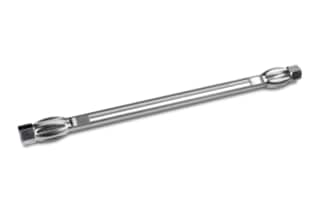
|
Chemistry |
C18 |
|
Separation Mode |
Reversed Phase |
|
Particle Substrate |
Hybrid |
|
pH Range Min |
2 pH |
|
pH Range Max |
12 pH |
|
Maximum Pressure |
6000 psi (415 Bar) |
|
Endcapped |
Yes |
|
Bonding Technology |
Shield RP18 |
|
Silanol Activity |
Low |
|
Particle Shape |
Spherical |
|
Particle Size |
5 µm |
|
Endfitting Type |
Waters |
|
Pore Size |
125 Å |
|
Format |
Column |
|
Surface Area |
175 |
|
System |
HPLC |
|
USP Classification |
L1 |
|
Inner Diameter |
3 mm |
|
Length |
150 mm |
|
Carbon Load |
15 % |
|
UNSPSC |
41115709 |
|
Brand |
XTerra |
|
Product Type |
Columns |
|
Units per Package |
1 pk |

XTerra Shield RP18 Column, 125Å, 5 µm, 3 mm X 150 mm, 1/pk
Using the XTerra Shield RP18 Column, overcome the significant limitations of silica-based reversed-phase packing materials, particularly their hydrolytic instability at high pH. Waters' unique organic/inorganic Hybrid Particle Technology (HPT) is used in the lab equipment, allowing it to offer various advantages over traditional silica columns. The Waters XTerra range of reversed-phase HPLC columns is the first commercially available silica-based column alternative.
Invest in the Xterra Shield RP18 Column to increase peak shape performance for highly basic compounds quickly and easily. A general-purpose, hybrid-based, reversed-phase C18 column with Waters patented embedded polar group technology is used in the lab. When compared to a silica-based column, the XTerra Shield RP18 column is a first-generation column that delivers greater pH stability.
The Waters XTerra Shield RP18 offers significant advantages over traditional silica columns on the market. Mechanical strength, extremely spherical shape, purity, pore dimensions, surface area, particle size tailoring, pore dimensions, surface area, and surface chemistry are among them. Traditional bonding agents are used by the lab equipment to achieve this. It also allows the XTerra Shield RP18 column, an important piece of general-purpose lab equipment, to achieve optimal shape performance for extremely basic substances, maintain high separation efficiency, and increase pH stability. You can operate within a wide pH range with the XTerra Shield RP18 Column.
The XTerra Shield RP18 Column is made from a high purity methyl hybrid material that is made in a similar way to high-purity silica, with one important difference: the XTerra material is made from the mixed condensation of two high purity monomers rather than one. The XTerra
Shield RP18 Column's Hybrid Particle Synthesis is done with tetraethoxysilane (TEOS) and methyltriethoxysilane (MTEOS). The XTerra Shield RP18 Column, like all Waters lab equipment, is built to ISO 9001 standards, guaranteeing that each step is completed to the highest standards and with the tightest tolerances.
Protect your analytical column using the XTerra Shield RP18 VanGuard Cartridge, 125Å, 5 µm, 2.1 mm X 5 mm, 3/pk. The cartridge prevents any contaminants from entering the mobile stream, ensuring that the analytical results are accurate.
Across What pH Range Does The Waters XTerra Shield RP18 Column Operate?
The XTerra Shield RP18 Column, as indicated here, demonstrates excellent performance across a wide pH range of 2 to 12. Its versatility allows for reliable separations and analysis of compounds across various pH conditions.